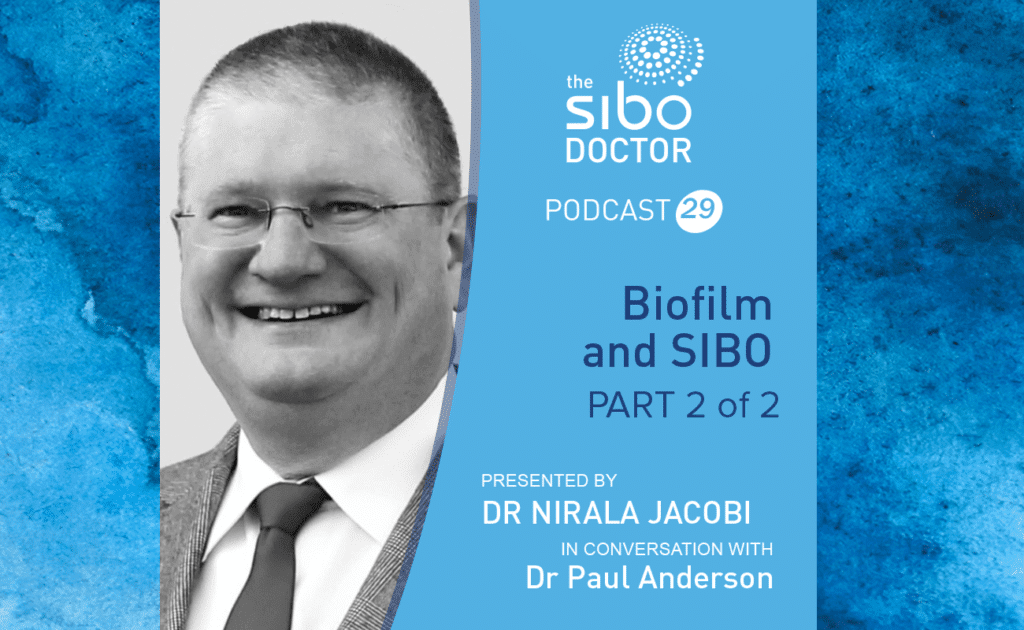Part 2 of our conversation with Dr Paul Anderson all about SIBO and biofilm.
Dr Anderson is a Naturopathic Doctor and medical director of the Advanced Medical Therapies Clinic focusing on the care of patients with cancer and chronic disease. Former positions include Professor of Pharmacology and Clinical Medicine at Bastyr University and Chief of IV Services for Bastyr Oncology Research Centre. Dr Anderson is a graduate of NCNM and began instructing classes at naturopathic medical schools in the early 1990s. He continues to hold board review classes and CME courses for most of the Canadian and US ND programs and continues his educational outreach through www.consultdranderson.com.
Enjoying the podcast? Please leave us a review!
Apple Users
How to leave us a review on your iPhone or Ipad
- Open Apple’s Podcast app.
- Go to the Search tab.
- Enter ‘The SIBO Doctor Podcast’.
- Tap ‘Search’ on your keypad.
- Tap the SIBO Doctor icon when it comes up.
- Tap the Reviews tab.
- Scroll down to ‘Ratings & Reviews’
- Tap the stars to leave a rating
- Tap ‘Write a Review’ to leave a review’
- Hit send
Android Users
How to leave us a review on your device
- Open Stitcher
- Go to the Search tab.
- Enter ‘The SIBO Doctor Podcast’.
- Hit search
- Tap the SIBO Doctor icon when it comes up.
- Scroll down to ‘Be the first to review this show’.
- Tap the stars to leave a rating
- Enter your review
- Hit ‘Post Review’
Topics discussed include:
- How Dr Anderson came to study this topic.
- The concept of normal biofilm as compared to pathological biofilm.
- The role of phase 1 in the building of pathological communities, and where they are typically located.
- How do you assess for biofilm? Lab options include:
- Labs in the US that do residue measurements from blood samples.
- Research labs that biopsy blood vessel walls and then can see the biofilm.
- Empirical evidence.
- How do you figure out what treatment is working?
- Biofilm response time – if there are gut problems or chronic infection problems, and you treat your patient with a biofilm disruption protocol and see little/no change (immune or other) after 3-4 weeks – then that is likely not their primary issue.
- Warn your patients about the immune system upregulation when the biofilm is broken open – the potential for symptomatic flares.
- Adrenal reserves in chronically ill patients being so low that there is a lack of ability to produce sufficient cortisol to balance the immune response – tactics to avoid this discomfort.
- Treatment trial for 4-6 weeks with biofilm disruption looking for healing crisis response. Considerations include:
- Adrenal support for chronically ill patients.
- Aromatic herbs to treat the bugs released – Mexican oregano, olive leaf, thyme and rosemary combination. Aromatic herbs treat both bacterial and fungal overgrowths – use for about 1 week.
- If there’s an immune reaction then rotate the biofilm support to confuse the bugs.
- Stool test 1-2 weeks after biofilm healing crisis usually shows completely different findings than before doing the treatment.
- What does the pathogenic phase 1 biofilm respond to? Products like n-acetylcysteine (NAC), serrapeptase, and phenolic compounds.
- How do you know if someone has a phase 1 or a phase 2 biofilm?
- How to move up the ladder from gentle to more impactful biofilm disruptors if you are not seeing a response in your patient.
- Weakly bound bismuth thiol complex with black cumin as an over the counter option – however, it is not as strong as a wedge as the strongly bound complexes (prescription).
- Stool test showing low secretory IgA – does this indicate low adrenal reserve and a more reactive patient in terms of biofilm treatment?
- Pseudomonas scaffolding – one of the best starters of biofilm in humans (and we all have a little of it).
- Biofilm hives – the interactions between organisms leading to the formation of a new organism as a group.
- If patients respond empirically to gentler treatments, like NAC, then there is no necessity to go beyond this.
- What about candida and biofilm formation?
- How to differentiate between die off and biofilm disruption, or do they come hand in hand?
- Do not start right away with biofilm, start with antimicrobials and see if you get a response, then if the patient progression plateaus initiate biofilm protocols. Alternatively, if the patient is referred to you and nothing has worked with them to shift their presentation try a milder biofilm disruption to gauge response.
- Do not start biofilm disruption in a constipated patient – attend to opening the elimination channels first.
- If the patient response to treatment is minor, or if the patient presents with issues but lab results show nothing much, suggest proceeding to biofilm protocol.
- Start with enzymes and NAC to gently disrupt biofilm then work up to stronger prescription compounds for biofilm disruption.
- Biofilm disruption protocols – you must see a response to know that it is working.
- Typical biofilm protocol length of time – 4 weeks.
- Cell turnover across the entire GIT has a mean of 3-9 days, per cell, if there is normal methyl cycle support.
- Tread carefully with low dose B vitamin support with SIBO in case of over methylation.
- Dysbiotic bugs thriving on B vitamins and other nutrients – if you give your patients nutrients and their symptoms flare consider dysbiotic metabolism stealing nutrients.
- Tactics with tougher dysbiosis cases – attend to dysbiosis before giving patients nutrients so that bugs are killed first and then the patient can metabolise the nutrients, or begin with low dose nutrients to support during dysbiotic readjustment.
- Histamine, candida, and the aldehyde link – Dr Anderson’s thoughts on how to navigate their common aldehyde pathway.
- Aldehyde pathways use a lot of thiamine – how to integrate with candida and histamine support.
- What are the B vitamins do we want to be cautious of in light of inadvertently feeding the dysbiotic bugs? The methyl donors.
- Histamine and Mast Cell Activation Syndrome (MCAS) – the use of B5.
- How to start with sensitive patients with issues pertaining to histamine, sulfates, and/or aldehydes.
- Start with trace minerals and B1 – will not aggravate bugs.
- Then add B-minus on top of that.
- Add some kind of mast cell stabilizer – a flavonoid.
Resources
- Consult Dr Anderson
- Advanced Medical Therapies – Dr Anderson’s Clinic in Seattle
- Dr Anderson’s Biofilm course
- Free further resources
- Biofilms – what have we learnt from the research?
- NDNR – Naturopathic Doctor News & Review
- Product mentions
- Ben Lynch’s B-minus formula for super sensitive people to avoid feeding dysbiotic bugs.
- Priority 1 formulation – methyl balance
- Containing B1 to mitigate aldehyde response
- Containing Biotin – a neuroprotectant which also does not aggravate during dysbiosis.

